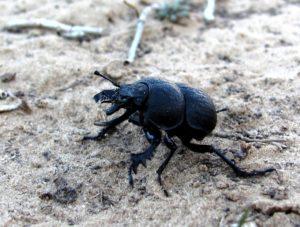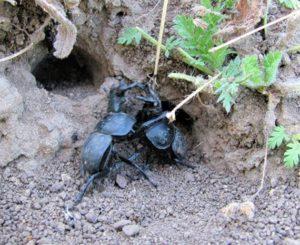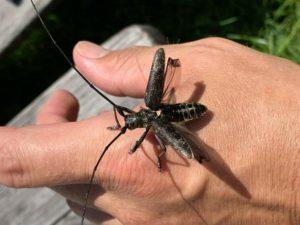Snow beetles: aggressive beauties and how to stop them
Experienced gardeners and gardeners know that the number of species of harmful insects operating on the site is simply huge. Most of them harm green shoots and leaves, and most often each specific insect species prefers one or more types of cultivated plants. But, the snow beetle is completely illegible in food and eats almost all the greens that it comes across.
Content
Strigun beetle: photo
Who is the snow beetle
Name: Beetle strigun or handsome
Latin: LethrusClass: Insects - Insecta
Squad: Coleoptera - Coleoptera
Family: Dung beetles - Geotrupidae
 | Habitats: | Palearctic, fields and steppes |
 | Dangerous for: | greenery of various plants |
 | Means of destruction: | special preparations, folk methods |
The snow beetle is a member of the dung beetle family of diggers, and it is also often called the redhead beetle, snow beetle or bighead beetle.
The body length of the strigons averages 1,5-2,5 cm, and only in rare cases can it reach 3,5 cm. The body, head, legs and jaws of the insect are large and massive. Thanks to this body structure, the beetle easily digs deep holes.
Males have special appendages on their jaws that are shaped like fangs. The paws of the insect are covered with many hard hairs, and there are claws at the ends. The flying wings of the snowmen are reduced, and the elytra are not divided and look more like a hard shell.
The color of the body and limbs of the snow beetle is black, most often matte. Sometimes a glossy sheen of blue tint may be present in the color.
Where does the snow beetle live
The habitat of representatives of this species is located within the Palearctic. The largest number of snow beetles is concentrated in Central Asia. The conditional extreme points of the range of these beetles are considered to be the Balkan Peninsula in the west, the Orenburg region in the north, Mongolia in the east, Iran and Afghanistan in the south.
Snow beetle lifestyle
Striguns live in deep burrows that they dig on their own. The depth of such an underground dwelling can reach 50 cm. Inside the hole, insects arrange several branches with small “rooms” at the ends, in which they prepare food for future offspring.
Adult individuals throughout their lives fill the prepared premises with pieces of green shoots and leaves. Bacteria and fungi process the accumulated greenery and turn it into silage, which subsequently feed on newborn larvae.
What harm does the snow beetle cause
In the process of harvesting food stocks, beetles of this species eat almost everything. They destroy:
- young shoots;
- leaves;
- inflorescences;
- kidney.
If no measures are taken to combat beetles, then only 10 adults can cause serious damage to all plants within 5-7 square meters. More often the following crops become victims of snowstorms:
- sunflower;
- corn;
- garden strawberries;
- grapes;
- Strawberry;
- decorative flowers.
Signs of the appearance of snow beetles on the site
There are only two main signs that snow beetles “worked” on the site:
- Characteristic cuts. In the process of accumulating stocks, beetles of this species “cut off” pieces from leaves, shoots, flowers and other green parts of the plant. It is for this reason that the beetles got their name among the people.
- The presence of holes. The burrows of these beetles have a fairly wide entrance and are clearly visible on the surface of the earth.
How to get rid of snow beetles
This type of beetle is quite difficult to drive out of the site. They breed very actively, and deep burrows help them hide and wait out processing by many means.
Special drugs
Treatment with chemicals does not always bring the desired effect in the fight against snow beetles.
The best insecticides against Striguns are considered:
- You decide;
- Arrivo;
- Diazinon.
Folk methods
There are not many folk recipes that give results in the fight against harmful beetles. The most effective of them are:
One of the selected means is poured into the mink of an insect. The procedure should be performed at the time of day when the beetle is likely to be inside - before dawn or after sunset.
This method is indeed very effective in controlling insects, but the problem is that the substances that make up the foam are toxic and can be absorbed into the soil, making it unsuitable for growing cultivated plants.
A solution of 2 liters of water and 100 ml of oil is poured into holes. Getting into the respiratory organs of insects, the oil simply blocks their access to oxygen. As a result, insects crawl out of their homes and die from suffocation.
Digging up the soil to a depth of up to 30 cm at least several times a year will regularly destroy the pest's home and destroy most of the future offspring. It is especially important to carry out the procedure in spring and autumn.
hair gnaw beetle
Among the people, women of fashion were frightened by a beetle with a swift or a hair-biter. Allegedly, if this creature gets tangled in the hair, it will make a big bald spot, cutting off the hair with an unpleasant rattle. But another beetle is considered a hair-biter - a spruce or pine barbel.
It terrifies many people. Often, in the hottest time, the swift beetle sits on light-colored clothes of people or bare parts of the body to cool down and rest. They look intimidating, but apart from an unpleasant image, they do nothing wrong to people. They feed on coniferous wood, but are not so common as to be a malicious pest.
Conclusion
Snow beetles are far from the best neighbors for farmers. If you do not interfere with their existence and do not take any measures to combat them, then soon a large colony of such insects will live on the site. Even a few beetles can harm crops, so you need to understand that a larger number of individuals can completely destroy the entire crop.
Previous

